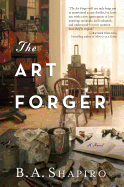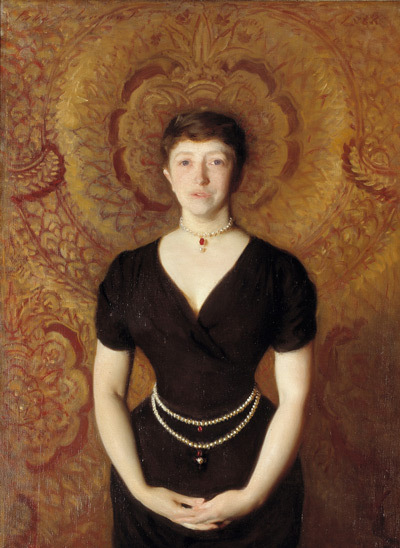The Art Forger
by B.A. Shapiro
In The Art Forger, B.A. Shapiro's sixth and best suspense thriller yet, Claire Roth, an accomplished painter in her own right, uses her skills to paint forgeries for Repro.com. The company sells her art work to clients who know the paintings are fake--for a "reasonable" price customers can enjoy the experience of having great masterpieces adorning their walls. Claire is especially good faking paintings by Edgar Degas. She hates to do it, but she's very good at it and the money allows her to pay her bills, just barely.
But first some history, true and false. In March 1990, two men stole 13 works of art from the Isabella Stewart Gardner Museum in Boston. The catch included such priceless masterpieces as Rembrandt's Storm on the Sea of Galilee and Vermeer's The Concert. Today, the value of the paintings would be over $500 million. For two decades, the FBI has investigated the robbery, following leads from all over the world. The museum still asks anyone who has any information about the theft to contact the FBI. A $5-million reward awaits. All true.
However, there was one "stolen" painting that never existed--Degas's After the Bath. It's a painting whose existence was created by Shapiro in order to provide a masterpiece around which her story is carefully built. And not just one story, but three. Shapiro artfully weaves three separate tales to tell the story of the art forger. The first is about Claire and her reproduction job and her desire to make it as a painter. The second is a flashback story from three years ago, about Claire and her lover, Isaac Cullion, whom Claire met when he was a teacher and she his student. Finally, there is the story told through letters written by Isabella Stewart Gardner, one of the greatest female art patrons, to her (fictional) niece Amelia in the 1880s-90s, when Gardner was in Paris looking for artworks to acquire and for artists--including Degas--to meet and befriend (true).
And so, when Aiden Markel, a gallery owner who knows Claire and Isaac, comes to her apartment with a financially rewarding proposal to paint a copy of the stolen Degas's After the Bath, a favorite of hers, she's both repulsed and intrigued. It would be challenging, and the money would be welcome. Markel also offers Claire his gallery for her own show, her first ever, a great opportunity to display her ongoing series of window paintings. She finally agrees, as long as the painting will never be public and will remain only in the hands of the mysterious wealthy collector who thinks he will have the stolen original. One day, in a big crate, the masterpiece to be copied is delivered--she stares at it "as if my eyes are tethered to the canvas." Markel has promised her the original will be surreptitiously returned to the Gardner once her copy is completed.
Claire begins her forgery. Shapiro does an excellent job of giving us fascinating information and details about the art of painting and how a good forgery is actually made: "I've ground the underpaint--flake white, raw umber, and turpentine mixed with a touch of sienna to warm it up--to my exacting and secret recipe. A red sable brush, ridiculously expensive, but the only kind of soft brush Degas ever used, stands at the ready. I immerse the brush in the small bowl of underpaint, close my eyes, and visualize the final painting.... I begin. Underpainting is fast and straightforward. The perfect first step for a long project."
As she paints, her thoughts turn to the origins of Bath. She knows the painting well, having stood before its genius at the museum many times. But something seems wrong. Could this be a forgery? Could the original have been a fake? If so, where is the real Bath? She sets out to learn more about Gardner's relationship with Degas and arranges to meet Sandra Stoneham; her grandmother, Amelia, was Gardner's niece.
All the threads now start to intertwine as Shapiro deftly takes on the role of magician, dazzling us with ingenious slights of hand and a narrative juggling act. Watching her bring all the pieces together makes for an exciting and very pleasurable read. If you love art, a mystery, and a tale of unrequited love, this tale is for you. --Tom Lavoie
View the book trailer for The Art Forger here.









 Isabella Stewart Gardner is such an entrancing and vivid figure in The Art Forger. She collected everything, from Rembrandts to lace to ironwork sconces. And then built a Venetian villa in the middle of Boston to hold it all.
Isabella Stewart Gardner is such an entrancing and vivid figure in The Art Forger. She collected everything, from Rembrandts to lace to ironwork sconces. And then built a Venetian villa in the middle of Boston to hold it all. The infamous Gardner heist of 1990, where two thieves took 13 works of art, including Rembrandts, a Vermeer, and--of course--a Degas--has there been any sort of resolution?
The infamous Gardner heist of 1990, where two thieves took 13 works of art, including Rembrandts, a Vermeer, and--of course--a Degas--has there been any sort of resolution?